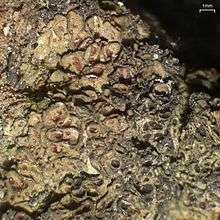Heppia
Heppia is a genus of olive, brownish, gray, or blackish squamulose, crustose, or peltate lichens.[2] It is in the family Heppiaceae. It grows on rock or soil in arid sites around the world, in habitats similar to those favored by Peltula, which is similar but has a different cyanobacterium as the photobiont.[2] It lacks a medulla that is separate from the photobiont layer.[2] It is a cyanolichen with the photobiont cyanobacterium being Syctonema (or Syctonema-like).[2] The lower surface is paler than upper surface, and has numerous rhizoidal hyphae attaching it to the substrate.[2] The fruiting structures (ascomata) are apothecias immersed in the thallus with red to red-brown urn shaped (urceolate) to flat or slightly convex discs.[2] An exciple may or may not be present.[2]
| Heppia | |
|---|---|
 | |
| Heppia lutosa | |
| Scientific classification | |
| Kingdom: | |
| Division: | |
| Class: | |
| Order: | |
| Family: | |
| Genus: | Heppia Nägeli ex A.Massal. (1854) |
| Type species | |
| Heppia adglutinata (Kremp.) A.Massal. (1854) | |
| Synonyms[1] | |
Species
- Heppia adglutinata
- Heppia arenacea
- Heppia conchiloba
- Heppia despreauxii
- Heppia lutosa
References
- "Synonymy: Heppia Nägeli ex A. Massal". Species Fungorum. CAB International. Retrieved 2014-10-31.
- Lichen Flora of the Greater Sonoran Desert Region. Vol 1, Nash, T.H., Ryan, B.D., Gries, C., Bugartz, F., (eds.) 2001,